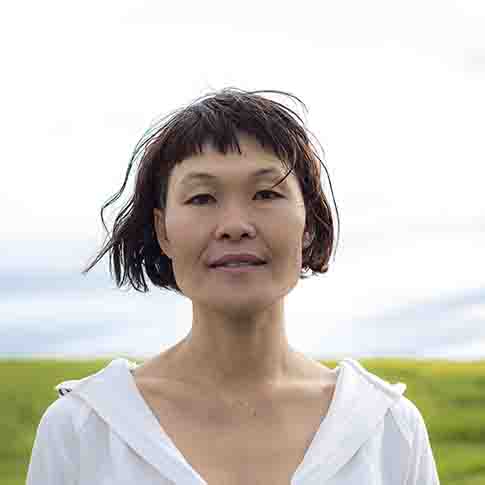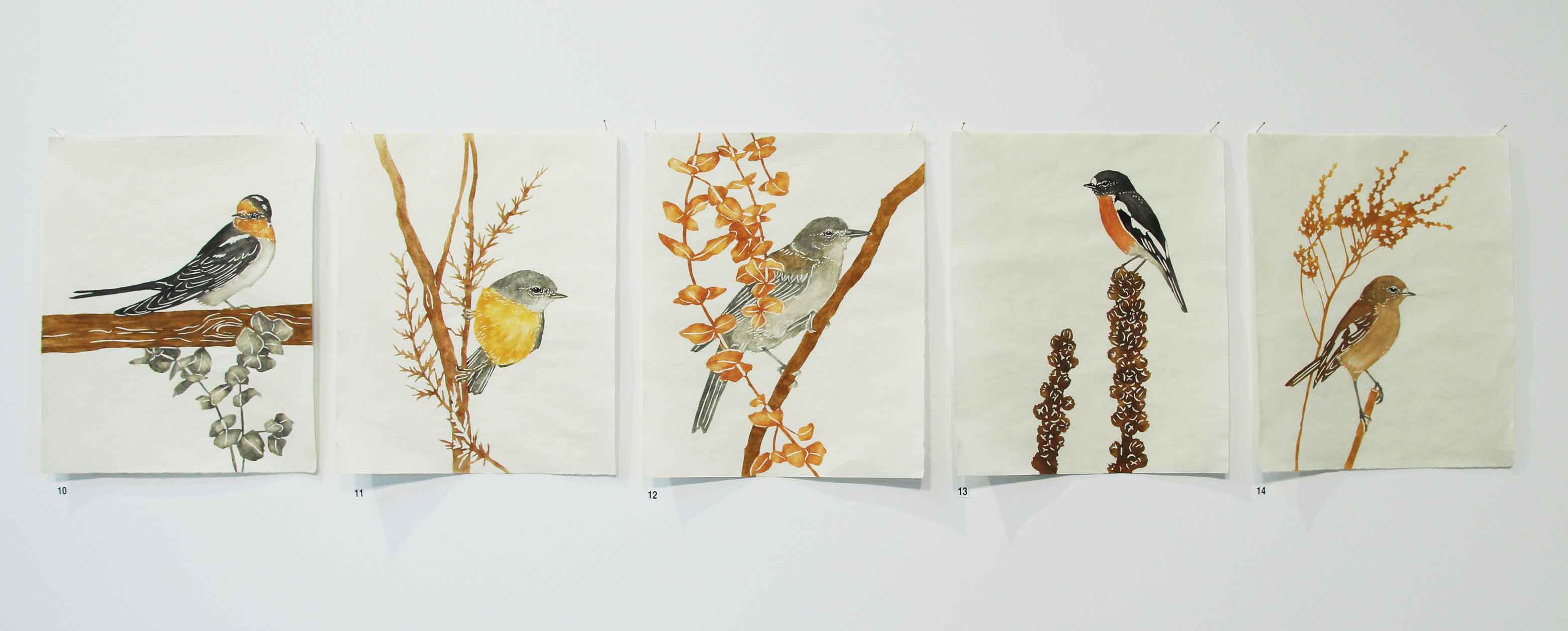
Feature
Melinda Heal

Beyond the Surface: Melinda Heal’s Textile Dye Practice
Japanese Somé dye traditions Katazome and Yuzen offer richly detailed patterns and graphic elements in textile design through resist dye processes. Beyond kimono, these dye practices are surfacing in contemporary textile art due to their expressive potential. Australian artist Melinda Heal translates this capacity of Japanese Somé in her contemporary practice.
Melinda’s training at the renowned Kyoto Seika University began as an exchange student ten years ago and culminated in a Masters of Visual Arts in Textiles, immersing the artist in the history and living tradition of textiles in Kyoto. After four years in Japan, Melinda returned to Australia and established her studio practice in Canberra. Following her 2016 solo exhibition at The Japan Foundation Gallery, Sydney (Some: Dyeing the Australian Environment), the artist expanded her locally sourced natural dye development, building an Australian palette for her environmentally conscious bodies of work.
Recent solo exhibition, Dyeing the Liminal, delivered the vivid results of Melinda’s experiments with natural dye developed from found materials in Somé practice, informed by her 2018 artist residency in Nagano. We caught up with the textile artist to learn about the roots of Melinda’s career, the practicalities of working with traditional dye processes outside Japan, and her unique model of contemporary Somé practice.

Alison: It’s now ten years since your first experience at Kyoto Seika University, an institution globally renowned for excellence in traditional artisanal art and design education. How did your education at Kyoto Seika University shape your early career?
Melinda: Those years of study had a huge influence on my life, really. It was really only by chance that I participated in a katazome class while first on exchange. It was so much fun and totally different to any textile dyeing I’d done before – and now here we are!
Because of the connections formed during that one-year exchange, I was able to return as a post graduate student on a (Japanese government supported) MEXT Scholarship. Those four years really forced me to not only study the techniques further but also develop my own style – to find my own Australian take on these very traditional (and not widely used internationally) techniques.
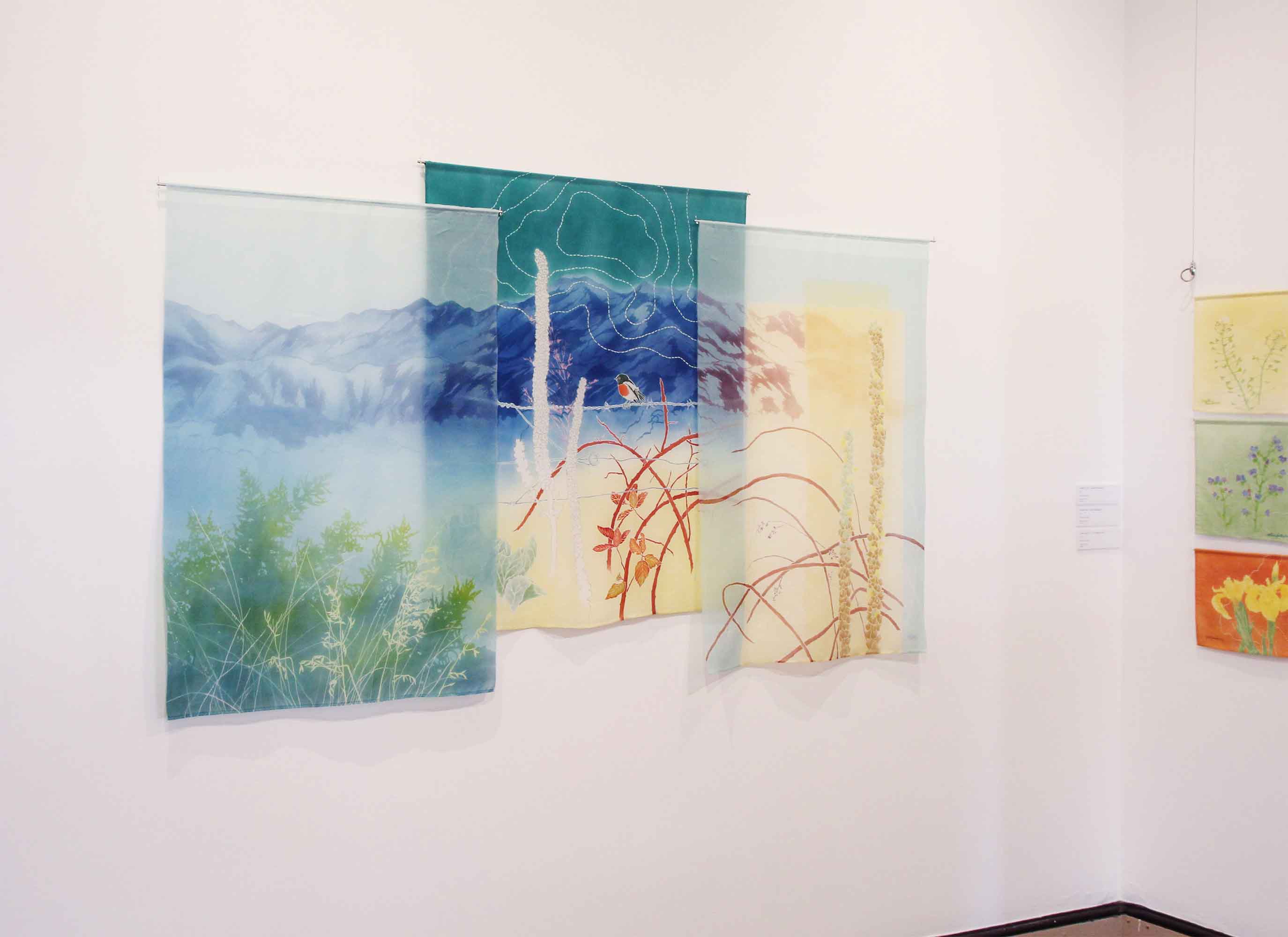
Melinda Heal, From Narrabundah Hill (2017). Katazome and yuzen on silk, approx 2.1 x 1 metre in three panels. Image courtesy of the artist.
It was really only by chance that I participated in a katazome class while first on exchange.

Photo: Melinda Heal, Plants of Nakajo (2018) from the series Beautiful Plants of Nakajo where the artist dyed imagery of local plants on washi using colour from mineral pigments produced from local rocks and earth. Image courtesy of the artist.
Alison: Yes—that uniquely ‘Australian’ take on Japanese dye is very present in your work through imagery of local botany and wildlife, but also in your dynamic approach to practice. Even after establishing roots in Canberra, you’ve sustained a deep connection with Japan. How do your annual trips to Japan feed into your practice, and how important is this connection to the future of your work?
Melinda: Going back to Japan every year means I continue to learn, maintain connections and networks and keep getting opportunities coming my way. I was able to have a solo show in Kyoto (at Galerie H20) in 2017 while I was there which was really lovely. I was able to show new work I’d made since leaving Japan, and it was sort of a reminder to my professors and other supporters that I was still creating, even though you sort of lose contact a bit being in different parts of the world.
I’ve begun to feel it’s important for me to work on my own style. Rather than going back to ask my professors for advice or emulating their styles, like I might have done as a student, I need to find a way to make these techniques relevant to me and my place in Australia. Part of this has been figuring out materials and supplies I can use in place of Japanese ones, but it’s also about leveraging the fact that I am here in Australia and quite removed from the traditional centre of Somé. Earlier, I had thought that fact was like an annoying stumbling block, like I was missing out or at a disadvantage with access to materials or tools. But now actually I’m starting to see it as a freeing advantage.
Instead of going back to Japan to seek out advice and gathering up all the supplies I can fit in my luggage –well, I do still seek out some specialised goodies – I go to re-connect with peers and have been introduced to friends of friends in a similar age bracket and we end up encouraging each other with our diverse careers post graduation. That’s a really wonderful connection to have.
Alison: It’s also wonderful to see how Japanese artist residency programs are adding a new dimension to your career. Can you describe your experience during the Nakajo Artist Residency program in Nagano late last year?
Melinda: It was an amazing experience! I wasn’t really sure what to expect, so I went in with a very open mind. I thought at the very least I’d be able enjoy the quiet of the Nakajo countryside for 10 weeks! It turned out to be a very intense experience, but in a good way.
The residency program actively encouraged me (and the two other participating artists) to interact with the local community wherever possible, so we ended up at all kinds of events – from the local sports day, to the high school concert, to the local shrine’s autumn harvest ceremonies…and even helping harvest rice in shin-deep mud! We could hardly believe such a small community had so much going on all the time.
So balanced with all this community engagement was making artwork which distilled the natural environment around the town. It seemed like it might be too much to juggle those two things, but I really enjoyed it and it all seemed to fit together. For example, the local mountain walkers club took us on a hike up the highest peak close to Nakajo, called Mushikura-yama. On the hike I found stones that I was able to use as pigment colour for a series of work depicting local plants (see image). Another time I went on a stroll with one of my friendly neighbours and some of the wildflowers she showed me ended up in my artwork. We even collected fallen walnuts which I made into a great inky brown dye. So, in the end the artwork really was intertwined with my crazy, daily life there!
There were no facilities specific to textile dyeing – the house I was provided for the 10 weeks had two rooms – a tatami room which I used as a bedroom and a second room with wooden flooring which I used as a studio. I really had to think about how I could make work with a condensed version of the resist dye techniques I usually use. I didn’t want to be messing with chemical dyes outside the walls of a properly equipped studio so I really threw myself into collecting local stones and also plants to create pigments and dyes instead.
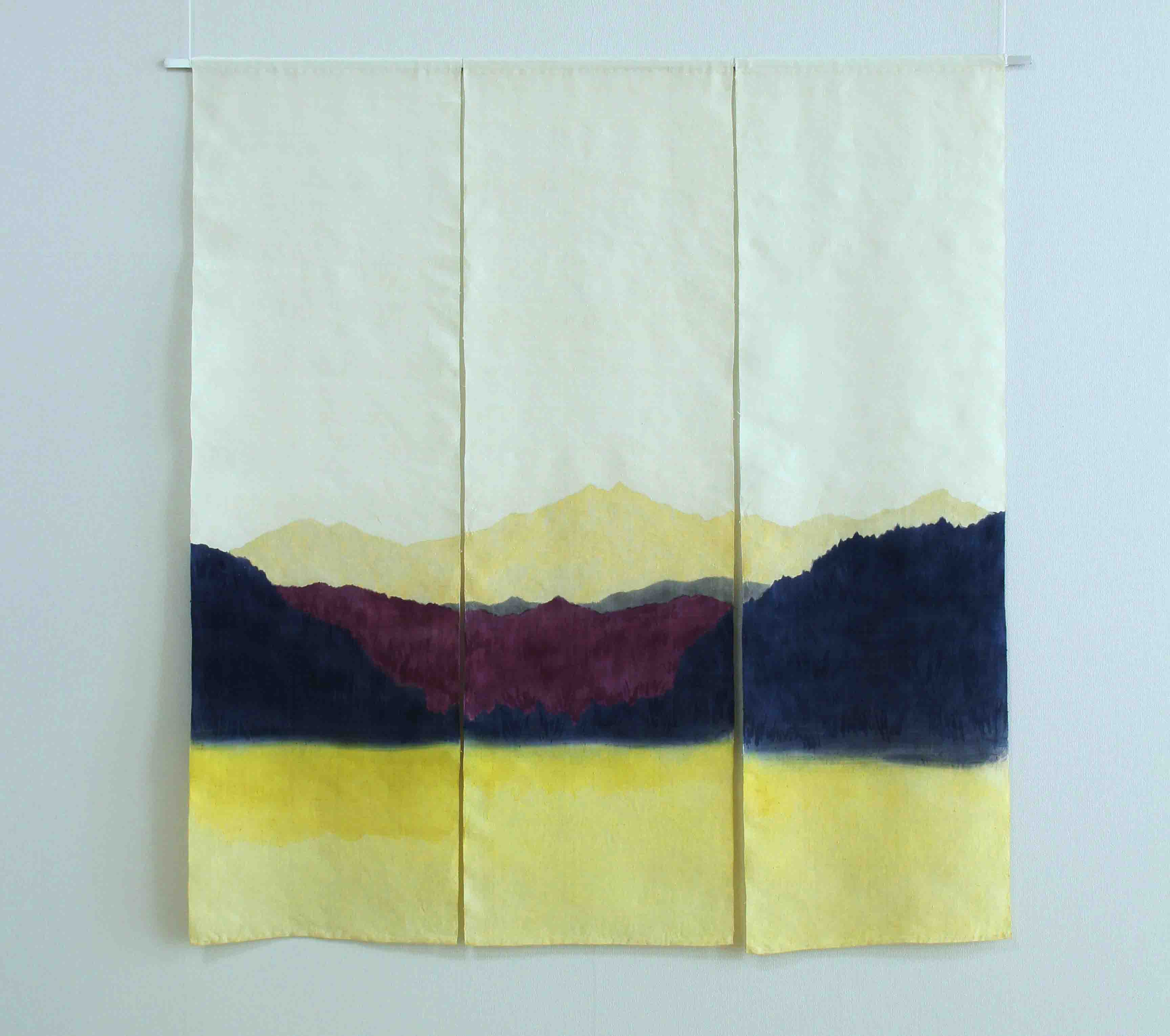
Photo: Melinda Heal, Northern Alps in Early Autumn (2018). Dyed on silk in Nagano during Nakajo Artist in Residence program. Colours all obtained from natural dyes, including the invasive weed Goldenrod (yellows) gathered locally along the river. Image courtesy of the artist.

Photo: Rocks collected by the artist in Nakajo before being ground in mortar and pestle. Image courtesy of the artist.
Alison: That improvisation produced some really interesting results too! Returning to your routine studio practice, are there any challenges for you in Canberra working within traditional dye processes? Are the materials readily available locally?
Melinda: Certainly when I started out, there was a hard slog of figuring out what materials could be replaced with local ones, what equipment was non-negotiable and what could be “fudged”. I’m now at a point where I’ve come up with a compromise that I’m happy with.
The main factor that is still challenging is the difference in climate here – it’s so dry here in Canberra: both in summer and in winter. I have to pay special attention to the resist paste adding extra ingredients and a bit of humidity in the room so that it’s less likely to dry out and crack. I should just move to Brisbane or somewhere further north where it would probably be fine.
Apart from a few specialised dye brushes made of deer hair, and fine metal tips for applying yuzen resist, everything else I can source here. Oh – and de-fatted rice bran is an ongoing headache! It’s one of the ingredients in the resist paste but I’m determined to figure out a substitute in the near future.
Alison: For me, traditional textiles draw associations of highly skilled but often tedious, physical, laboured processes. How do you navigate the practicalities of daily studio practice with traditional dye processes?
Melinda: I think something that really sets these techniques apart (even from painting) is the way you have to complete steps in an order: each step takes the time it needs and you can’t move forward until each step is completed. You have to cut a stencil, make the resist paste, apply the paste to the fabric, let it dry, mix up the fixative, apply the fixative, let it dry…You sort of end up waiting for things to dry a lot! But it actually fits well around daily life, if you can be organised. You go okay, ‘if I apply this paste tonight, it has all day to dry. I can soak the fixative before I go to bed, apply it before I head out for the day and when I get home later it will be ready to dye.’ Once you find a rhythm like that, it’s great.
This all means that once you start that process rolling, it sort of needs your sustained attention and you’re committed to seeing that piece through to completion. If not, the paste might dry out too much or the fixative will cure too far and make it hard to get the dye into the cloth.
The techinques I use, katazome and yuzen, were traditionally carried out by a group of artisans across various ateliers, so with the division of labour there would be one person responsible for stencil carving, another atelier would be the paste-maker, at another they would be applying the paste and doing the dyeing. Now you’ve got contemporary practitioners doing all of these steps themselves so you really do need to figure out your own rhythm and pace yourself. You just have to expect everything to take longer – you can’t be doing the work of five different artisans simultaneously. Though its fun to try!
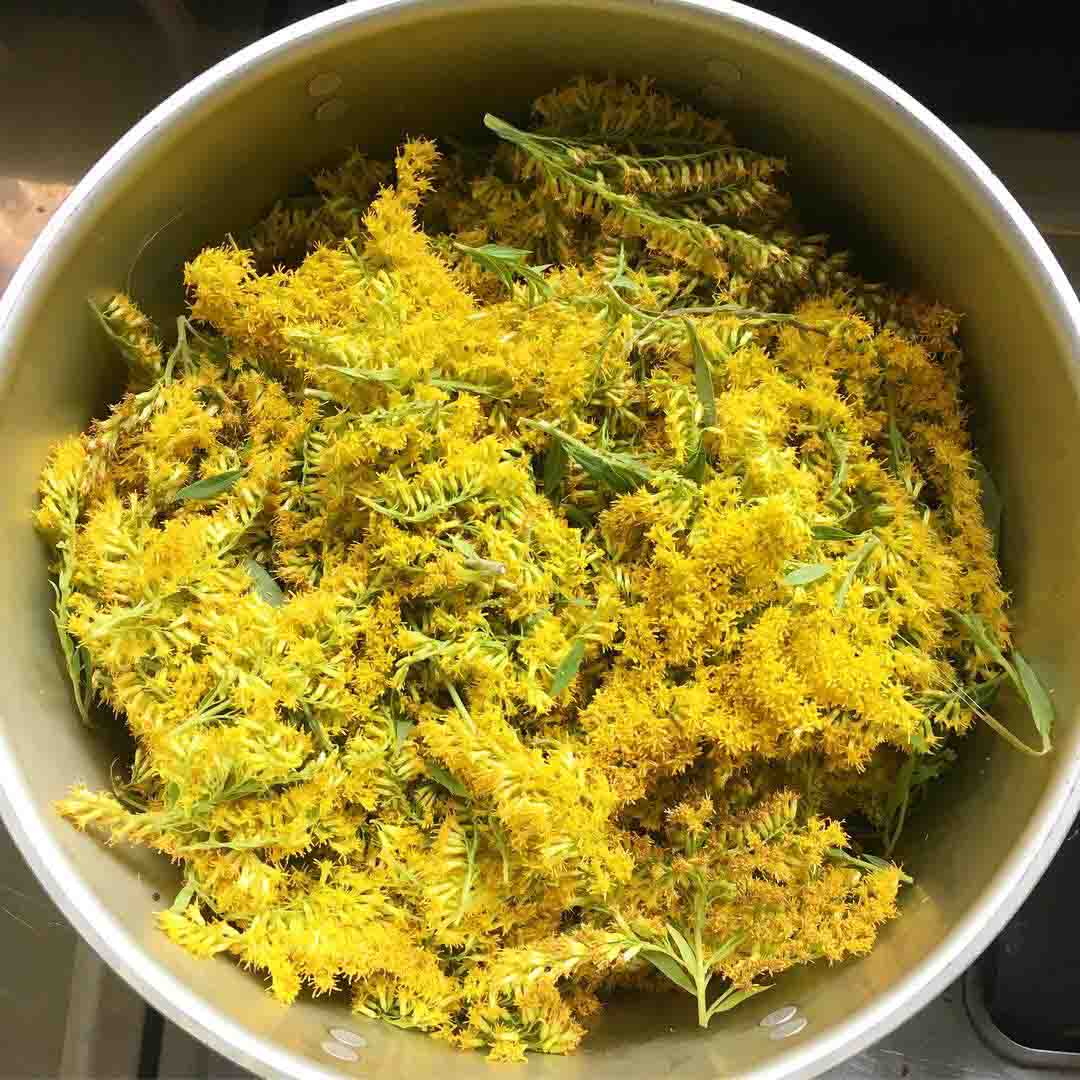
Photo: Goldenrod flower heads, source of yellow dye. Image courtesy of the artist.
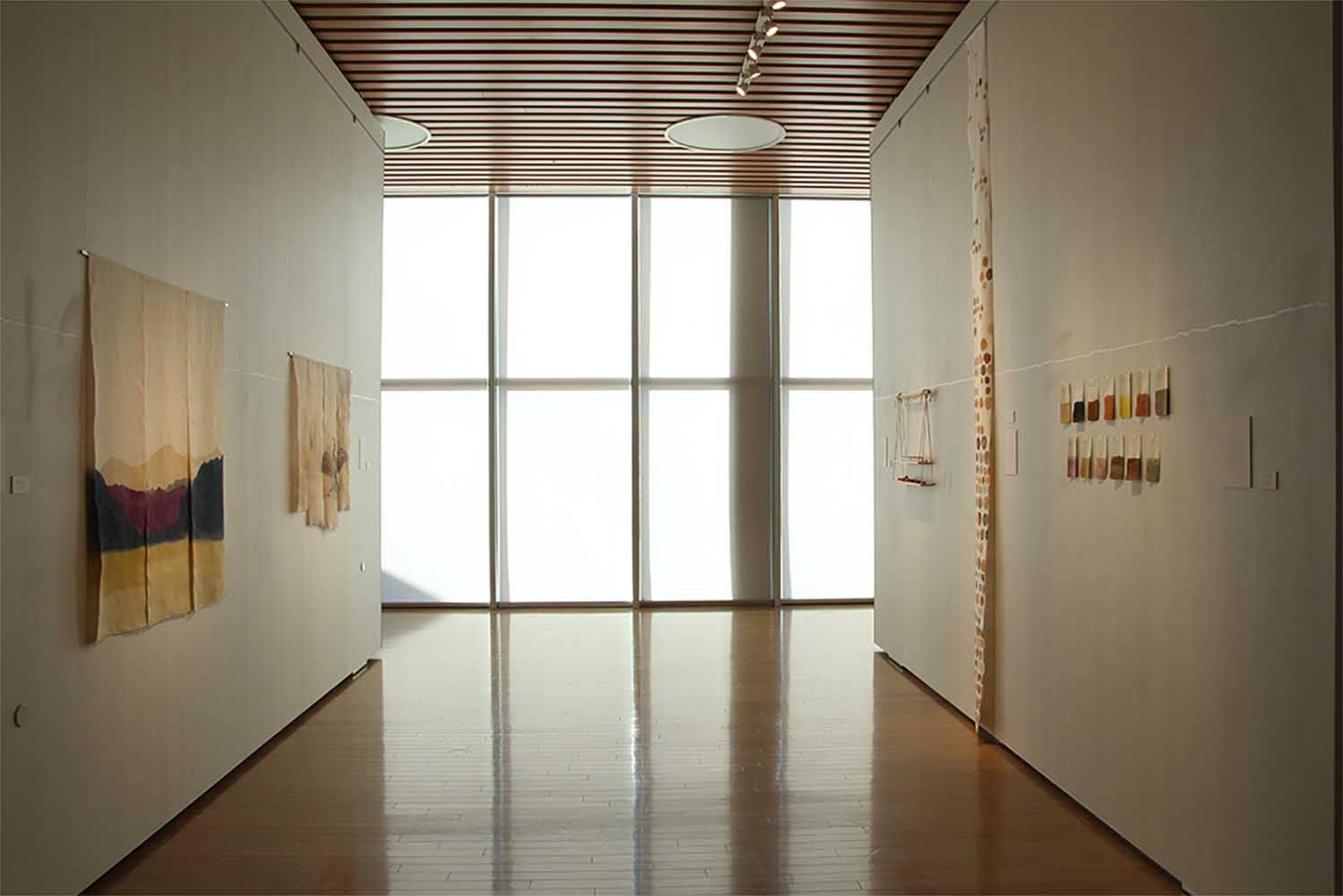
Photo: Install view of Melinda Heal’s residency exhibition in Nagano City Hall Gallery, October 2018. Image courtesy of the artist.
Alison: The ecological narratives of sustainability and wildlife protection are enduring themes in your work. Do you find it’s possible to extend sustainable practices in the studio?
Melinda: As a textile artist it’s hard to ignore how resource hungry dyeing textiles can be. Dyeing using chemical dyes can be done responsibly to a point, but lately I have been turning more to natural dyes and also a lot of mineral pigment colour, as it just feels more sustainable. It also means free art materials!
After a storm I can collect strewn branches from my favourite Eucalypt species and I have the makings of a strong orange-brown dye. And finding colour in stones has been a revelation. You use all of the stone, you only need small amounts, and there is virtually no run off.
I get a feeling this is going to be a long-term project for me – to keep increasing the palette of plants I know how to work with, and to document place through colour as well as subject matter.
Alison: Katazome and yuzen offer rich illustrative and graphic potential in dye practice, and your work captures the layered processes of mark making, with delicate and supple lines softening blocked areas of colour. Your sketchbooks suggest the origins of the refined silhouettes in your textile works have quite a loose and gestural origin. How does drawing factor into your process?
Melinda: I’ve always loved and been encouraged in drawing. I think I’ve become a lot looser with drawing in the last five years or so. I struggled with katazome and yuzen techniques at first because they require you to have a fixed, clear underdrawing before you start any of the physical labour. You need to have a design ready to trace precisely onto stencil paper (or your line work ready to go for tracing onto the silk) before you proceed to apply paste to the fabric. At least, that’s the way it would work traditionally. That’s why there’s so much effort and time expended on the drawing, design stage in these studio processes.
I’m careful and tedious in other things but I’m actually a bit blasé about the design stage. Since I’m working with transparent fabrics and layered compositions I actually do a lot more guesswork and add as I go. Of course, I have an idea of how the composition will be before I start but I can refine and add as I go on the actual fabric. I try to keep line work more fluid than in traditional yuzen, and the dye work is sometimes more akin to watercolour effects. I figure that is more my style, so why not combine the two?
I still love to draw without the expectation of using it for textile works too. There are some limitations with what you can achieve with these dye techniques and some subjects just appeal more to me in a drawn state. I’m keeping a kind of sketch diary at the moment and adding to it every now and then – working with fine, scratchy line work is good practice for the eye but it’s quite removed from the look of my finished works.

Photo: Crushing up local stone to create mineral pigment. I’ve used this in combination with katazome in new works including the work you see above the fireplace in From Narrabundah Hill. Image courtesy of the artist.
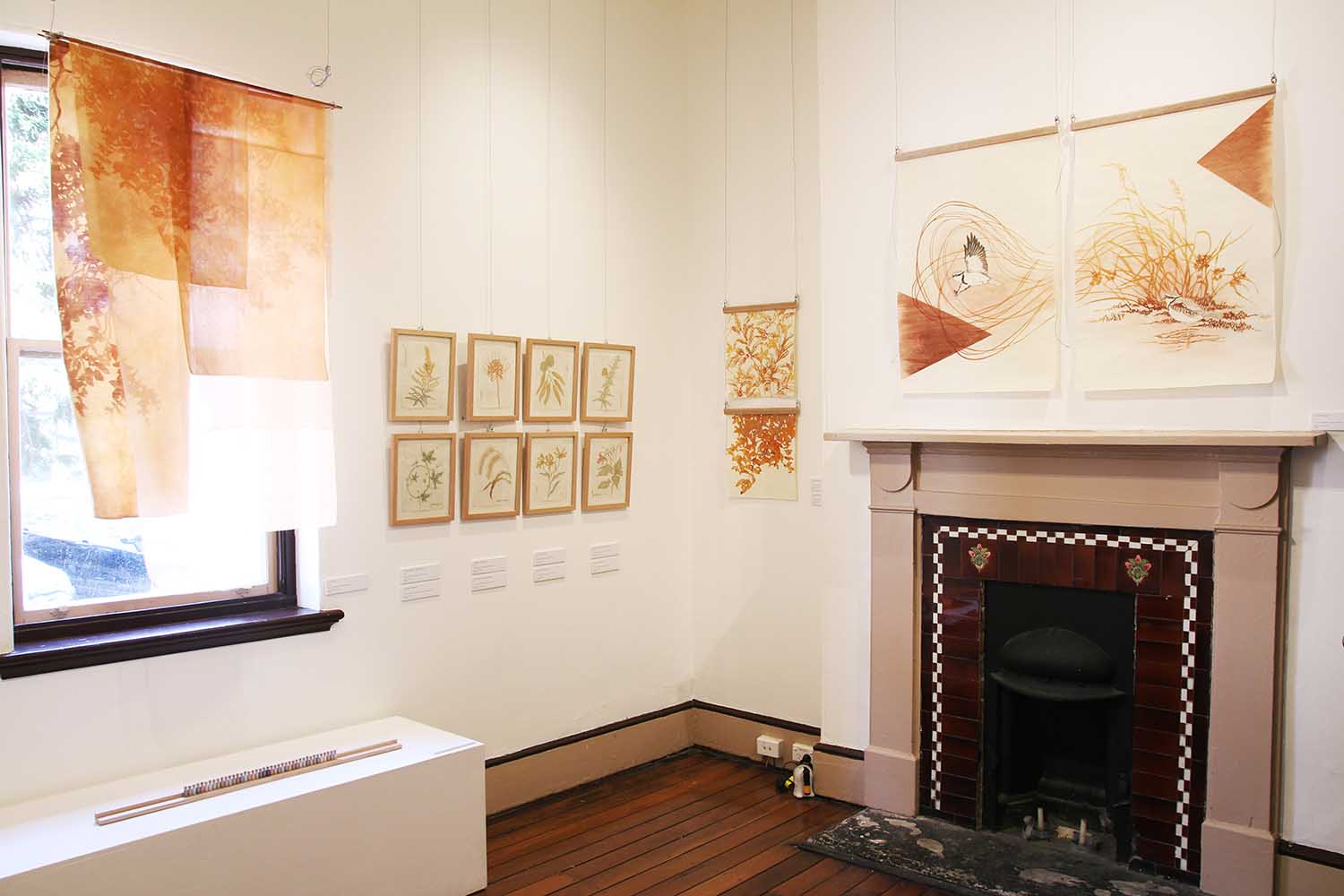
Photo: Installation view of Melinda Heal’s exhibition Dyeing the Liminal at Timeless Textiles in Newcastle, 2019. Image courtesy of the artist.
Alison: Your recent solo exhibition in Newcastle offered audiences new insights to your processes, revealing the magic of the ground pigment and natural dye. What new spaces did you explore in this exhibition and how are you approaching other projects on the horizon?
Melinda: Dyeing the Liminal in Newcastle discussed edges – the complexity in the landscape along fence lines and riverbeds. It is a culmination of two years of work and includes a selection of work from my residency in Nagano last year. It was my first time including so many works on paper in a solo show – using katazome with washi.
In May I have another solo show at the CSIRO Discovery Centre in Canberra, and I’m calling it Beautiful Weeds & Other Obsessions. In the past year I’ve been a bit obsessive with collecting rocks and stones and crushing them up really finely to use as pigment colour on cloth and paper.
Initially, I was just looking for interesting colours from around Canberra, but now I’ve also been finding things further afield in Australia and also in Nagano last year. As well as using the colours as pigment in the works, I’ve been exhibiting the colours I find in tiny glass jars – sort of reminiscent of a tiny museum exhibit and they form a really beautiful palette of the area where they were sourced. This has been a really exciting and consuming practice and it’s really been pushing my work closer to a more natural, earthy palette.
I’ll be showing works using these pigment colours alongside floaty layered silk pieces – some of which are dyed with Eucalyptus dyes – in the CSIRO space, particularly ones depicting ‘beautiful weeds’, another favourite subject of mine. It will be interesting to bring these natural science themes together in a show at such an appropriate location.
Alison: A very fitting exhibition location for your pigment library! We look forward to seeing it grow as your career reaches new territory. Which artist would you recommend to broaden our understanding of contemporary katazome and yuzen practice?
Melinda: I can’t get past works by legend Nishijima Takeshi (1929-2003). Having recently been living near Japan’s Northern Alps, I was blown away by his mountain range works from the 1980’s all over again. Two years ago on a Japan trip I invested in a boxed monograph on his works and can look at it for hours trying to figure out how he did such interesting stuff with katazome!
Alison: For those who are now itching to try their hand at yuzen or katazome, where would you suggest they start?
Melinda: If you’re interested in starting out on a journey to learn these techniques, there are some old but useful books around in English available on katazome. There’s also quite a lot of information available on blogs and websites out there. Unfortunately, I’m not sure if there are any classes being taught in Australia. I do an occasional workshop but your best bet is still studying in Japan!
Alison: And finally, for those readers fortunate to be planning their next visit to Japan, can you share some ‘hidden gem’ recommendations for those seeking to soak up the dye culture?
Melinda: If you’re lucky enough to be wandering around Kyoto:
* Get yourself to Some Seiryukan Museum in Kyoto – take your shoes off and wander around on tatami to check out where dye techniques meet contemporary art.
* Go upstairs at the Itoen Tea House to find a museum of the CHISO yuzen kimono company. They often have spectacular examples of kimono from their collection on show.
Also, look out for yuzen ateliers in Kanazawa – birthplace of Kaga style yuzen. One comprehensive but small museum to visit is the Nagamachi Yuzen-kan.
Melinda Heal’s upcoming solo exhibition Beautiful Weeds & Other Obsessions will be held in the exhibition space at the CSIRO Discovery Centre, May 8–June 14, 2019 at the CSIRO Discovery Centre, Black Mountain site (Mon–Fri, 9am–4:30pm; closed weekends and public holidays). To learn more about the artist’s work, visit Melinda’s website.
Interview conducted by Alison Groves, April 2019
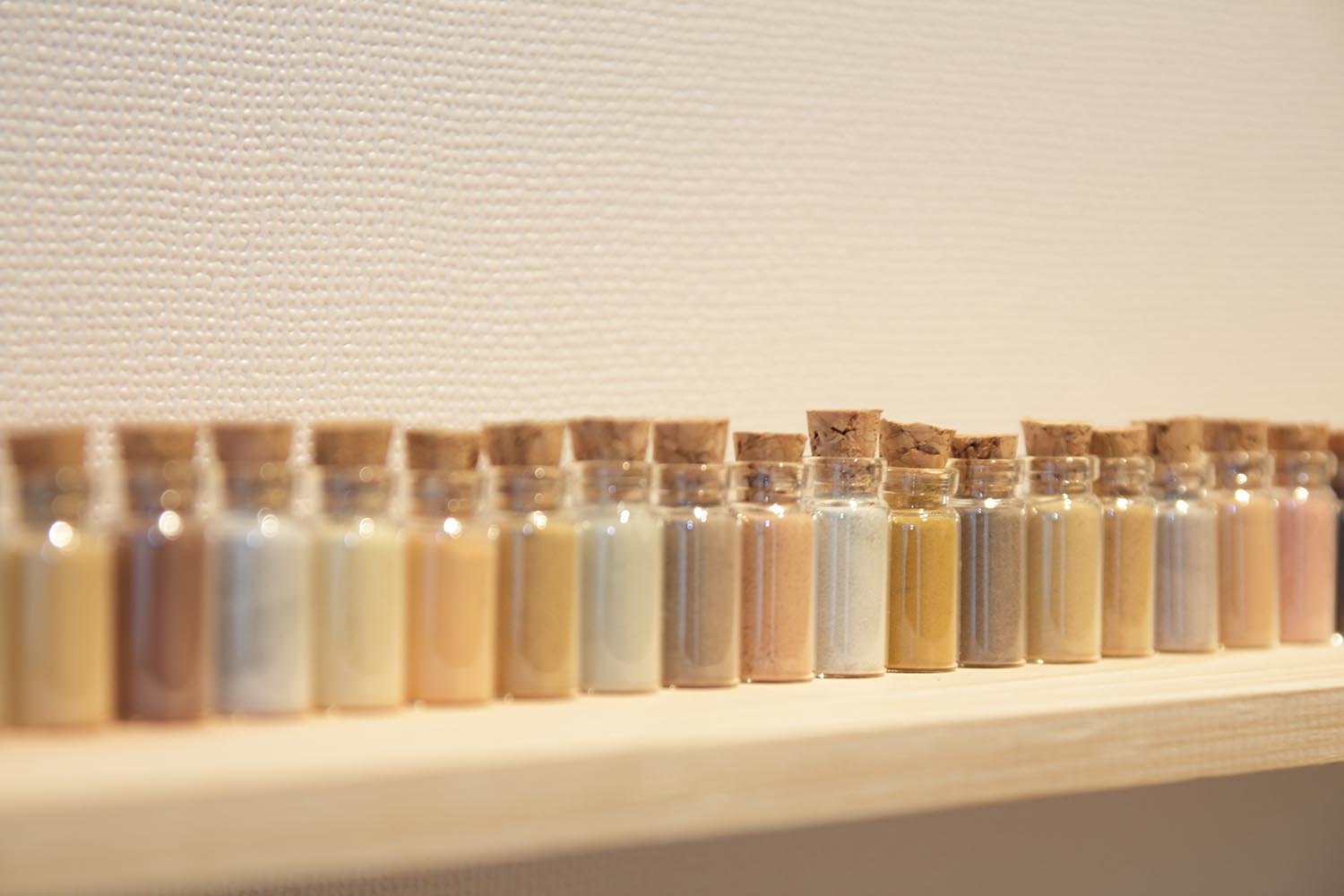
Photo: Melinda Heal’s mineral colour samples stored in glass vials. Image courtesy of the artist.


